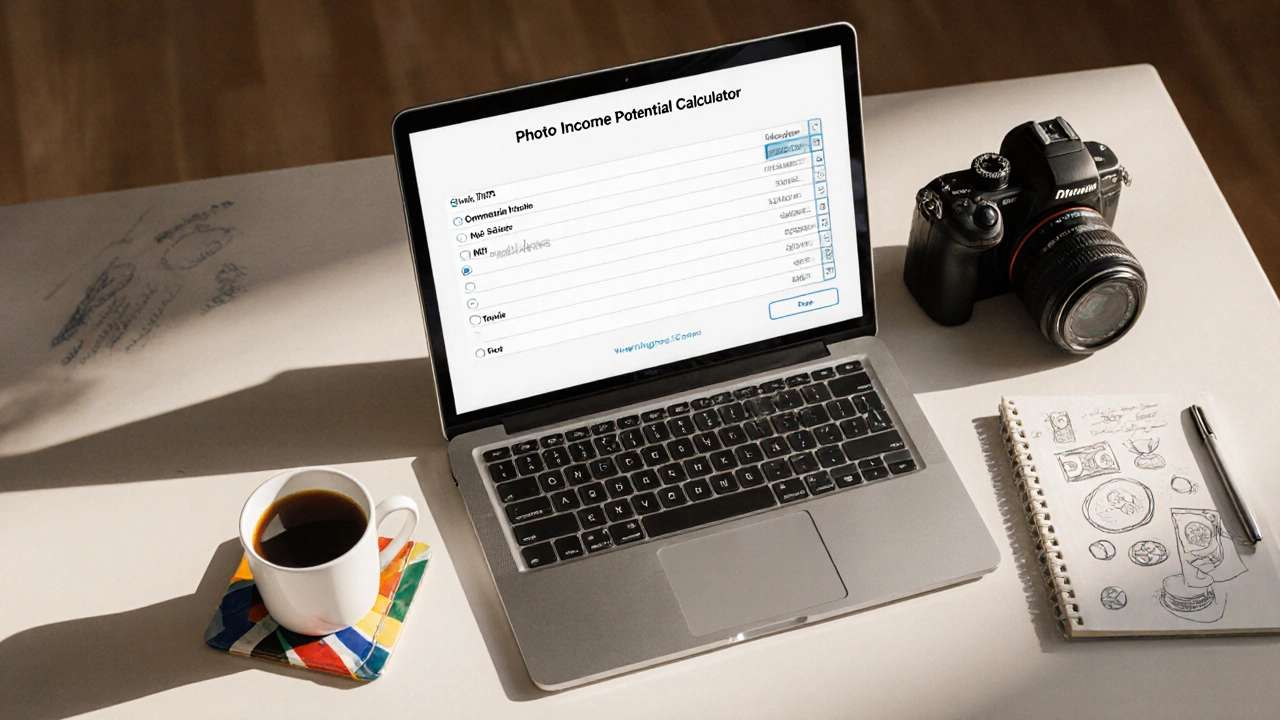Most Profitable Photo Types: How to Earn Top Money from Your Pictures
 Oct, 2 2025
Oct, 2 2025
Photo Income Potential Calculator
Estimated Monthly Earnings
$0.00
Based on your selections and inputs
Top Performing Categories
- 1 Stock Photography (Business & Tech)
- 2 Commercial Licensing
- 3 Fine-Art Prints
- 4 NFTs
Key Tips for Maximizing Income
- Maintain a consistent upload schedule (30-50/month for stock)
- Use high-quality keywords and metadata
- Build a strong portfolio for commercial clients
- Diversify revenue streams across multiple categories
Key Takeaways
- Stock photography of business concepts, technology, and lifestyle shots generates the highest recurring royalties.
- Limited‑edition fine‑art prints and NFTs can command huge one‑off fees when the creator builds a strong brand.
- Commercial licensing for advertising, packaging, and editorial use pays far more per image than typical micro‑stock sites.
- Travel and food photos earn well on niche marketplaces that cater to tourism boards and recipe publishers.
- Success depends on metadata quality, model‑release compliance, and consistent posting schedules.
Ever wondered which pictures actually fill your bank account? The truth is that not every photo earns the same amount - some niches practically print money, while others barely cover the cost of a memory card. Below we break down the top‑earning photo categories, where to sell them, and the exact steps you need to start pulling in real income.
1. Stock Photography: The Workhorse of Online Earnings
When most people think about selling images, stock photography is a broad‑scale market where agencies license images to businesses, marketers, and publishers for a fee. It’s the most reliable way to generate passive income because a single upload can be sold thousands of times across multiple agencies.
Which subjects dominate the stock photography market? Data from the major agencies (Shutterstock, Adobe Stock, Getty Images) consistently show three high‑performing groups:
- Business & Technology - office scenes, people using laptops, AI concepts, and clean product shots.
- Health & Wellness - fitness, nutrition, mental‑health imagery.
- Lifestyle & Diversity - authentic families, multicultural groups, everyday moments.
Why these topics? Companies allocate sizable marketing budgets to create relatable ads, and they need fresh, legally safe images every week. The royalty rates vary: micro‑stock sites usually pay $0.25-$0.75 per download, while premium agencies can offer $2-$10 per sale, plus recurring royalties for extended licenses.
Key tactics for maximising stock earnings:
- Shoot in high resolution (minimum 20MP) and use a neutral color profile.
- Keyword every image with at least 20‑30 relevant tags - include industry‑specific terms like “remote work”, “sustainable packaging”, etc.
- Maintain a model‑release library; agencies reject images without proper releases for recognizable people.
- Post consistently - 30‑50 new images per month keep your portfolio fresh and rank higher in agency search algorithms.
2. Commercial Licensing: One‑Off High‑Value Deals
Unlike the royalty‑based stock model, commercial licensing is a direct contract between a photographer and a client who pays a set fee for exclusive or semi‑exclusive use. This includes advertising campaigns, product packaging, and editorial spreads.
Typical rates (based on the US and UK markets in 2024) range from $500 for small local ads to $15,000+ for national TV campaigns. Because the fee is negotiated upfront, the photographer retains full control of the image’s future use.
Top commercial niches:
- Product Photography - high‑detail shots of tech gadgets, cosmetics, and food items for e‑commerce.
- Architectural & Real‑Estate - interior renders for property listings and design magazines.
- Fashion & Lifestyle Campaigns - curated lookbooks for boutique brands.
How to land these gigs:
- Build a clean, client‑focused portfolio website (use a simple .com domain, fast loading speed, and clear contact info).
- Network on LinkedIn and industry forums; many agencies post briefings for photographers.
- Offer a short “test shoot” at a reduced rate to get a foot in the door and prove your reliability.
- Write clear contracts covering usage rights, exclusivity period, and payment milestones.
3. Fine‑Art Prints: Turning Images into Collectibles
Fine‑art prints are high‑quality, limited‑edition reproductions sold directly to collectors or through galleries. The profit margin can be massive because you set the price, and the cost per unit drops dramatically after the first few prints.
Successful fine‑art photographers typically specialise in:
- Landscape‑scapes with dramatic lighting (e.g., sunrise over mountains, misty forests).
- Abstract, minimalist compositions that appeal to interior designers.
- Portrait series that tell a narrative, often printed on archival cotton rag paper.
Pricing model: Artists usually print 50‑200 copies per image, price ranging from $150 for small sizes to $2,500+ for large, framed editions. Sites like Saatchi Art and Etsy handle fulfillment, while Instagram serves as the discovery engine.
Pro tips:
- Invest in a high‑grade printer (e.g., Epson SureColor P900) or partner with a reputable lab.
- Certificate of authenticity adds perceived value and deters counterfeiting.
- Limited runs (e.g., “Only 30 copies”) create urgency and higher price points.

4. NFTs and Digital Collectibles: New Frontier for Photographers
NFT photography is the practice of tokenising digital images on a blockchain, allowing owners to prove scarcity and trade the artwork. While the hype has cooled, creators who focus on unique concepts (e.g., AI‑enhanced portraits, time‑based photo series) still fetch six‑figure sales.
Key platforms (2025): OpenSea, Foundation, and the newer Objkt.com for Tezos‑based NFTs, which offer lower gas fees and an eco‑friendly reputation.
Best‑practice workflow:
- Choose a blockchain - Tezos for low fees, Ethereum for broader audience.
- Mint the image with descriptive metadata (title, edition size, creator bio).
- Promote via Discord communities and Twitter/X, linking back to the mint page.
- Set royalty percentage (usually 5‑10%) to earn on secondary sales.
Most lucrative NFT niches:
- Generative art that incorporates photo elements.
- Historical or archival photographs that gain cultural relevance.
- Exclusive behind‑the‑scenes series from notable events.
5. Travel & Destination Photography: Niche Marketplaces Pay Premium
Tourism boards, airline marketing departments, and travel guide publishers constantly need fresh, high‑impact imagery of landmarks, cityscapes, and nature. Unlike generic stock, these images command higher fees because they’re tied to specific locations.
Top platforms for travel photos:
- Alamy - known for paying up to $20 per download for exclusive travel shots.
- 500px Marketplace - focuses on high‑quality travel and adventure images.
- Direct licensing via Getty Images’ custom sales team.
Tips to stand out:
- Capture the “golden hour” - soft light adds drama and reduces post‑processing time.
- Include human element (locals or tourists) to convey story.
- Use GPS metadata; many buyers filter by exact coordinates.
6. Food Photography for Publishers & Brands
Food imagery powers everything from restaurant menus to cookbook covers. Because it’s so visual, brands are willing to pay $150-$500 per plate for stylised shots, and editorial publishers can pay $300-$1,200 per image for magazine spreads.
Essential gear includes a macro lens (50‑100mm), a light‑tent, and colour‑calibrated monitors. Consistency in colour balance (especially reds and greens) is a make‑or‑break factor for clients.
Where to sell:
- Specialty stock sites like Foodiesfeed and Dreamstime Food.
- Direct contracts with local restaurants or food producers.
- Subscription services for restaurants (e.g., Snappr Food).
7. Photo Contests and Awards: Cash Prizes + Portfolio Boost
Winning a reputable competition can instantly add $5,000-$20,000 to your earnings and open doors to commercial work. Examples include the World Press Photo contest, National Geographic Photo Contest, and the Adobe Photography Awards.
Key considerations before entering:
- Read the theme and ensure your image tells a compelling story.
- Check the entry rights - some contests demand exclusive submission.
- Invest in a professional‑grade print for the judging process; many juries judge physical copies.
8. Building a Sustainable Income Engine
Putting all these revenue streams together creates a diversified portfolio that smooths out seasonal dips. Here’s a simple weekly routine:
- Upload 5‑10 new stock images (focus on business, tech, and lifestyle).
- Allocate 2‑3 hours to outreach - email potential commercial clients with a tailored mini‑portfolio.
- Spend 1 hour updating your fine‑art shop and promoting recent prints on Instagram.
- If you’re exploring NFTs, schedule a minting session once per month.
Track every transaction in a spreadsheet (date, platform, earnings, net profit after taxes). Review the data quarterly and double down on the categories that deliver the highest ROI (typically commercial licensing and premium stock).
| Photo Type | Typical Earnings per Image | Revenue Model | Key Platforms | Time Investment |
|---|---|---|---|---|
| Stock (Business & Tech) | $0.25-$10 per download | Royalties | Shutterstock, Adobe Stock, Alamy | Medium (shoot & keyword) |
| Commercial Licensing | $500-$15,000 per contract | One‑off fee | Direct client outreach, agencies | High (client meetings, revisions) |
| Fine‑Art Prints | $150-$2,500 per print | Product sales | Etsy, Saatchi Art | Medium (post‑processing, printing) |
| NFTs | $200-$20,000+ (initial + royalties) | Token sale + secondary royalties | OpenSea, Foundation, Objkt.com | Variable (minting & promotion) |
| Travel & Destination | $5-$20 per download (higher for exclusives) | Royalties / exclusive sales | Alamy, 500px, direct licensing | Medium (travel, location scouting) |
| Food Photography | $150-$1,200 per image | One‑off or subscription | Foodiesfeed, direct brand contracts | High (styling, lighting) |
| Photo Contests | $5,000-$20,000 (prize) + exposure | Prize money + portfolio boost | World Press Photo, Nat Geo | Low (single entry) |

Frequently Asked Questions
Which photo category yields the highest steady income?
Business‑oriented stock photography typically provides the most consistent royalties because businesses need fresh images every quarter for marketing campaigns.
Do I need a model release for every person in a stock image?
Yes. If a recognizable person can be identified, a signed model release is mandatory; otherwise agencies will reject the upload.
Is it worth investing in NFTs as a photographer?
NFTs can be lucrative for unique, limited‑edition works and when you already have a community that follows you. For most photographers, they’re a supplement rather than a primary income source.
How many images should I upload to a stock site each month?
Aim for 30-50 new, high‑quality uploads per month. Consistency improves your portfolio’s visibility in the agency’s search algorithm.
Can I sell the same photo on multiple platforms?
Yes, unless you sign an exclusive agreement. Non‑exclusive licenses let you list the same image on Shutterstock, Adobe Stock, and Alamy simultaneously.